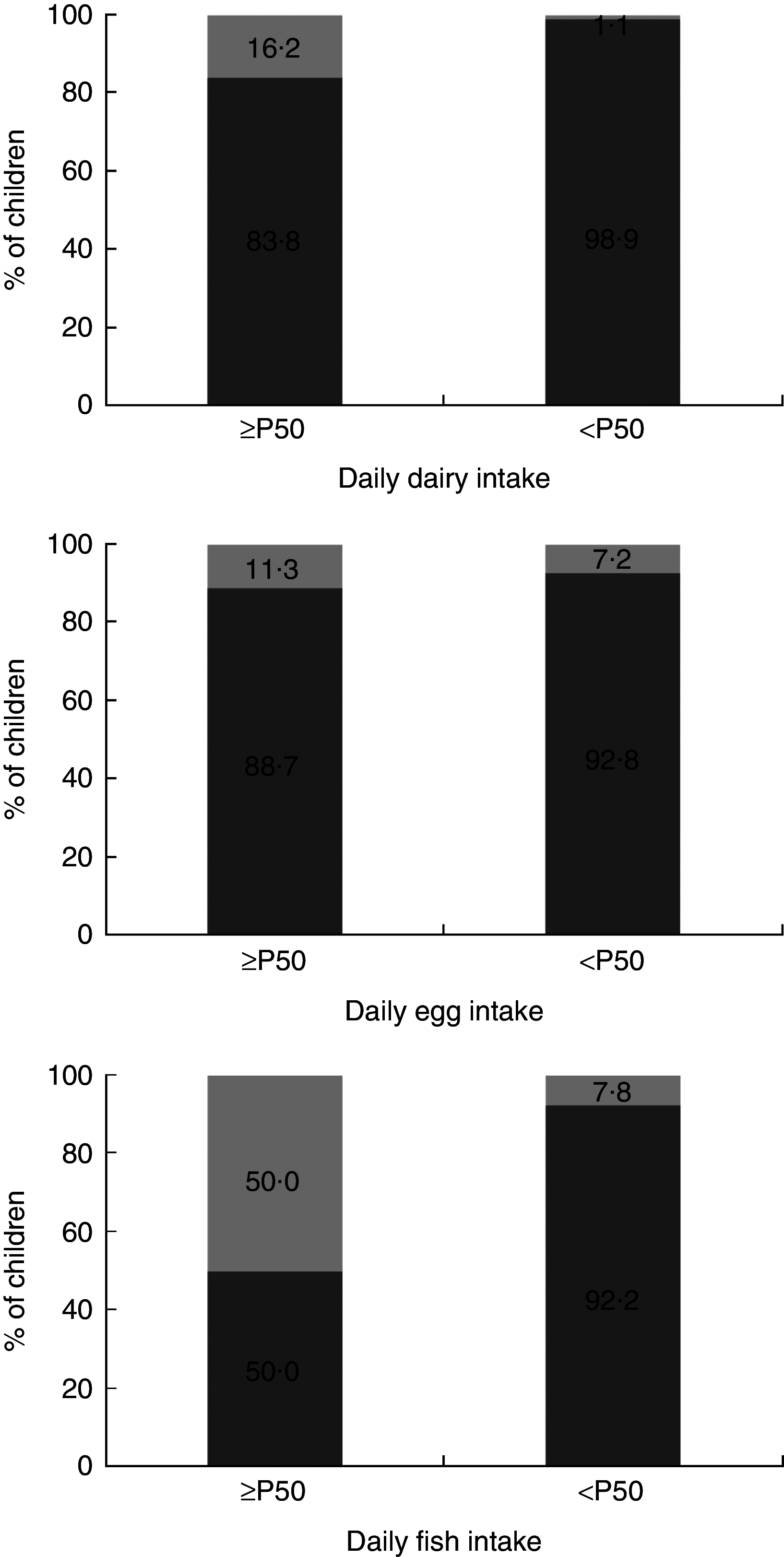Lower vitamin D intake is associated with low HDL cholesterol and vitamin D insufficiency/deficiency in Brazilian children
- PMID: 29478422
- PMCID: PMC10260741
- DOI: 10.1017/S1368980018000204
Lower vitamin D intake is associated with low HDL cholesterol and vitamin D insufficiency/deficiency in Brazilian children
Abstract
Objective: To evaluate the association of vitamin D intake with dyslipidaemia and vitamin D insufficiency/deficiency in Brazilian children and identify the main food group sources of this nutrient in the sample.
Design: A cross-sectional study carried out with a representative sample. Blood was collected after 12 h of fasting. Laboratory tests were performed to determine total cholesterol, HDL cholesterol (HDL-C), LDL cholesterol, TAG, apoB, apoA1, 25-hydroxyvitamin D and parathyroid hormone. Dietary intake was evaluated by a 24 h recall.
Setting: Viçosa, Minas Gerais, Brazil.
Subjects: Children between 8 and 9 years old enrolled in urban schools (n 378).
Results: We found an elevated prevalence of inadequate vitamin D intake (91·3 %), dyslipidaemia (72·8 %) and vitamin D insufficiency/deficiency (56·2 %). The food groups that contributed the most to vitamin D intake were dairy products and fish. Lower vitamin D intake was associated with increased prevalence of both low HDL-C (prevalence ratio=2·51; 95 % CI 1·02, 6·18; P<0·05) and vitamin D insufficiency/deficiency (prevalence ratio=1·61; 95 % CI 1·01, 2·58; P<0·05).
Conclusions: Given the elevated prevalence of inadequate vitamin D intake and its association with low HDL-C and vitamin D insufficiency/deficiency, it is important to develop specific actions in food and nutritional education as well as programmes that stimulate and facilitate access to vitamin D food sources, such as dairy products and fish.
Keywords: Dairy products; Dyslipidaemia; Fish; Micronutrients; Nutritional Deficiency.
Figures

 , <10 µg/d;
, <10 µg/d;  , ≥10 µg/d) according to the consumption of dairy products, eggs and fish (equal to or greater than the median, ≥P50; less than the median, <P50) by urban schoolchildren aged 8–9 years (n 378), Viçosa, Minas Gerais, Brazil, 2015. Dairy intake: P50=169·2 g/d (P<0·001*); egg intake: P50=16·7 g/d (P=0·184); fish intake: P50=6·7 g/d (P=0·009). *P<0·05 (Fisher’s exact test)
, ≥10 µg/d) according to the consumption of dairy products, eggs and fish (equal to or greater than the median, ≥P50; less than the median, <P50) by urban schoolchildren aged 8–9 years (n 378), Viçosa, Minas Gerais, Brazil, 2015. Dairy intake: P50=169·2 g/d (P<0·001*); egg intake: P50=16·7 g/d (P=0·184); fish intake: P50=6·7 g/d (P=0·009). *P<0·05 (Fisher’s exact test)Similar articles
-
Vitamin D insufficiency/deficiency is associated with insulin resistance in Brazilian children, regardless of body fat distribution.Public Health Nutr. 2017 Nov;20(16):2878-2886. doi: 10.1017/S136898001700194X. Epub 2017 Aug 22. Public Health Nutr. 2017. PMID: 28829285 Free PMC article.
-
Infants' Vitamin D Nutritional Status in the First Year of Life in Northern Taiwan.Nutrients. 2020 Feb 4;12(2):404. doi: 10.3390/nu12020404. Nutrients. 2020. PMID: 32033065 Free PMC article.
-
Prevalence and Correlates of Vitamin D Deficiency and Insufficiency in Luxembourg Adults: Evidence from the Observation of Cardiovascular Risk Factors (ORISCAV-LUX) Study.Nutrients. 2015 Aug 13;7(8):6780-96. doi: 10.3390/nu7085308. Nutrients. 2015. PMID: 26287235 Free PMC article.
-
Brazilian older adults' vitamin D insufficiency and deficiency: a systematic review and meta-analysis.Cien Saude Colet. 2025 Apr;30(4):e08072023. doi: 10.1590/1413-81232025304.08072023. Epub 2024 Apr 11. Cien Saude Colet. 2025. PMID: 40298712
-
Deficiency and Insufficiency of Vitamin D in Women of Childbearing Age: A Systematic Review and Meta-analysis.Rev Bras Ginecol Obstet. 2022 Apr;44(4):409-424. doi: 10.1055/s-0042-1742409. Epub 2022 Feb 24. Rev Bras Ginecol Obstet. 2022. PMID: 35211934 Free PMC article.
Cited by
-
Increased high-density lipoprotein cholesterol in patients with type 2 diabetes and its correlates: a cross-sectional, matched case-control survey.Eur J Med Res. 2024 Jul 2;29(1):355. doi: 10.1186/s40001-024-01950-0. Eur J Med Res. 2024. PMID: 38956709 Free PMC article.
-
Cardiometabolic risk factors in South American children: A systematic review and meta-analysis.PLoS One. 2023 Nov 22;18(11):e0293865. doi: 10.1371/journal.pone.0293865. eCollection 2023. PLoS One. 2023. PMID: 37992076 Free PMC article.
-
Total cholesterol and low-density lipoprotein alterations in children and adolescents from Brazil: a prevalence meta-analysis.Arch Endocrinol Metab. 2023 Jan 18;67(1):19-44. doi: 10.20945/2359-3997000000508. Epub 2022 Aug 4. Arch Endocrinol Metab. 2023. PMID: 35929904 Free PMC article.
-
Pro- and anti-inflammatory adipokines are associated with cardiometabolic risk markers in Brazilian schoolchildren.Eur J Pediatr. 2021 Sep;180(9):2931-2941. doi: 10.1007/s00431-021-04040-z. Epub 2021 Apr 9. Eur J Pediatr. 2021. PMID: 33834274
-
Diminished 25-OH vitamin D3 levels and vitamin D receptor variants are associated with susceptibility to type 2 diabetes with coronary artery diseases.J Clin Lab Anal. 2020 Apr;34(4):e23137. doi: 10.1002/jcla.23137. Epub 2019 Dec 3. J Clin Lab Anal. 2020. PMID: 31793694 Free PMC article.
References
-
- Holick MF (2007) Vitamin D deficiency. N Engl J Med 357, 266–281. - PubMed
-
- Holick MF & Chen TC (2008) Vitamin D deficiency: a worldwide problem with health consequences. Am J Clin Nutr 87, issue 4, 1080S–1086S. - PubMed
-
- Aryan Z, Rezaei N & Camargo CA Jr (2017) Vitamin D status, aeroallergen sensitization, and allergic rhinitis: a systematic review and meta-analysis. Int Rev Immunol 36, 41–53. - PubMed
Publication types
MeSH terms
Substances
LinkOut - more resources
Full Text Sources
Other Literature Sources
Medical
Miscellaneous

